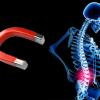CYBERMED LIFE - ORGANIC & NATURAL LIVING
CYBERMED LIFE - ORGANIC & NATURAL LIVING
 Magnet therapy, magnetic therapy, or magnotherapy is a pseudoscientific alternative medicine practice involving the use of static magnetic fields. Practitioners claim that subjecting certain parts of the body to magnetostatic fields produced by permanent magnets has beneficial health effects. These physical and biological claims are unproven and no effects on health or healing have been established. Although hemoglobin, the blood protein that carries oxygen, is weakly diamagnetic (when oxygenated) or paramagnetic (when deoxygenated) the magnets used in magnetic therapy are many orders of magnitude too weak to have any measurable effect on blood flow.
Magnet therapy, magnetic therapy, or magnotherapy is a pseudoscientific alternative medicine practice involving the use of static magnetic fields. Practitioners claim that subjecting certain parts of the body to magnetostatic fields produced by permanent magnets has beneficial health effects. These physical and biological claims are unproven and no effects on health or healing have been established. Although hemoglobin, the blood protein that carries oxygen, is weakly diamagnetic (when oxygenated) or paramagnetic (when deoxygenated) the magnets used in magnetic therapy are many orders of magnitude too weak to have any measurable effect on blood flow.
Magnet therapy is the application of the magnetic field of electromagnetic devices or permanent static magnets to the body for purported health benefits. Different effects are assigned to different orientations of the magnet.
Products include magnetic bracelets and jewelry; magnetic straps for wrists, ankles, knees, and back; shoe insoles; mattresses; magnetic blankets (blankets with magnets woven into the material); magnetic creams; magnetic supplements; plasters/patches and water that has been "magnetized". Application is usually performed by the patient.